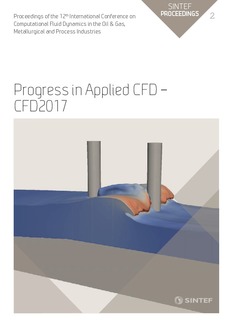| dc.contributor.author | Letout, Sebastien Romain | |
| dc.contributor.author | Ratvik, Arne Petter | |
| dc.contributor.author | Tangstad, Merete | |
| dc.contributor.author | Johansen, Stein Tore | |
| dc.contributor.author | Olsen, Jan Erik | |
| dc.date.accessioned | 2018-01-29T09:23:20Z | |
| dc.date.available | 2018-01-29T09:23:20Z | |
| dc.date.created | 2017-09-08T10:54:04Z | |
| dc.date.issued | 2017 | |
| dc.identifier.isbn | 978-82-536-1544-8 | |
| dc.identifier.uri | http://hdl.handle.net/11250/2480165 | |
| dc.description.abstract | The Si-Mn alloy process production in submerged arc furnaces (SAF) is investigated. The aim of the studies currently in progress is an enhancement of the knowledge about the key reactions and the mass transport phenomenon related to the metal production. Some small scale experiments on raw materials and bigger pilot scale experiments are done to understand local kinetic and its extension to real condition production furnaces. As it is impossible to observe what is happening in the core of the furnace during operation, excavation of the pilot scale furnace are realised after operations. Based on bibliographical description of similar processes, observations and species analyses after excavation, a numerical simulation is currently in development to test the hypothesis formulated about the internal behaviour of the furnace. As it is difficult to model the complex entire furnace, the work presented here is focusing on what are the phenomenas inside the coke bed, in the dripping zone where the slags flow around the carbon particles before reaching the bottom of the furnace. The thrickling of the slags across the coke bed can be evaluated by a simulation of the droplets finding their path by gravity through the packing of carbon particles. This study has to be very local in space and time, but can give some useful informations such as velocities and drag force. At a larger scale (ie furnace scale), the coke bed particles are modelled by a granular phase in an eulerian-eulerian representation where the slag phase flow interact in the same way as in the local study. The slag is found to flow across the coke bed under the form of droplets of a maximum diameter of 10mm. The apparent velocity of the fluid is about 0,12 m/s. However the residence time of the droplets is longer due to the liquid trapped along the coke bed. | nb_NO |
| dc.language.iso | eng | nb_NO |
| dc.publisher | SINTEF akademisk forlag | nb_NO |
| dc.relation.ispartof | Progress in Applied CFD – CFD2017 Selected papers from 12th International Conference on Computational Fluid Dynamics in the Oil & Gas, Metallurgical and Process Industries | |
| dc.rights | Attribution-NonCommercial-NoDerivatives 4.0 Internasjonal | * |
| dc.rights.uri | http://creativecommons.org/licenses/by-nc-nd/4.0/deed.no | * |
| dc.title | A multiscale numerical approach of the dripping slag in the coke bed zone of a pilot scale Si-Mn furnace | nb_NO |
| dc.type | Chapter | nb_NO |
| dc.description.version | publishedVersion | nb_NO |
| dc.source.pagenumber | 599-604 | nb_NO |
| dc.identifier.cristin | 1492037 | |
| dc.relation.project | Norges forskningsråd: 237738 | nb_NO |
| dc.description.localcode | SINTEF Proceedings er Open Access etter CC BY-NC-ND-lisensen (http://creativecommons.org/licenses/by-nc-nd/4.0/). | nb_NO |
| cristin.unitcode | 194,66,35,0 | |
| cristin.unitname | Institutt for materialteknologi | |
| cristin.ispublished | true | |
| cristin.fulltext | original | |

